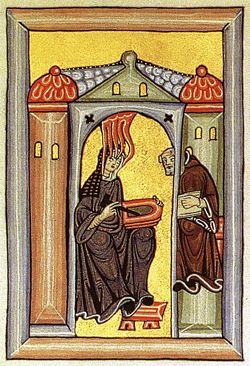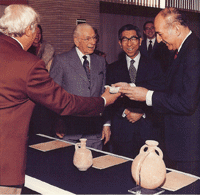
COGwriter
Do you know anything about the heretic Marcus?
Marcus was a second century Gnostic heretic, who was apparently affiliated with the heretic Valentinus.
The one book states:
Of Marcus himself we know nothing beyond the fact that he was one of the earlier pupils of Valentinus, or at any rate belonged to the earlier circle of Valentinian ideas. His date is vaguely placed somewhere about the middle of the second century; he is said to have taught in Asia Minor, and Jerome, two hundred years afterwards, states that he was an Egyptian (Mead, G.R.S. Fragments of a Faith Forgotten. Theosophical Publishing Society: London [1900] p. 359 http://www.sacred-texts.com/gno/fff/fff54.htm viewed 12/09/07).
It is possible that Marcus, who may have been an Egyptian (Valentinus was from Alexandria in Egypt), may also be the same Marcus that is listed in the apostolic succession lists of the Eastern Orthodox, but that is difficult to prove or disprove.
While the Eastern Orthodox venerate the memory of a Marcus they claim was bishop of Alexandria from A.D. 144-154, Roman Catholics consider that there was a leading Gnostic heretic named Marcus in the second century (see Marcus in The Catholic Encyclopedia).
The fact that Clement of Alexandria (a contemporary of Marcus) apparently used Marcus’ numbering system (see Marcus in The Catholic Encyclopedia), suggests, but does not prove, that this could be the same Marcus.
Interestingly, Marcus may have come up with a version of the eucharistic ceremony similar to that which both the Roman Catholics and Eastern Orthodox utilize today.
Notice what the Catholic saint Irenaeus wrote:
1. But there is another among these heretics, Marcus by name, who boasts himself as having improved upon his master. He is a perfect adept in magical impostures, and by this means drawing away a great number of men, and not a few women, he has induced them to join themselves to him, as to one who is possessed of the greatest knowledge and perfection, and who has received the highest power from the invisible and ineffable regions above. Thus it appears as if he really were the precursor of Antichrist. For, joining the buffooneries of Anaxilaus to the craftiness of the magi, as they are called, he is regarded by his senseless and cracked-brain followers as working miracles by these means.
2. Pretending to consecrate cups mixed with wine, and protracting to great length the word of invocation, he contrives to give them a purple and reddish colour, so that Charis, who is one of those that are superior to all things, should be thought to drop her own blood into that cup through means of his invocation, and that thus those who are present should be led to rejoice to taste of that cup, in order that, by so doing, the Charis, who is set forth by this magician, may also flow into them. Again, handing mixed cups to the women, he bids them consecrate these in his presence. When this has been done, he himself produces another cup of much larger size than that which the deluded woman has consecrated,) and pouting from the smaller one consecrated by the woman into that which has been brought forward by himself, he at the same time pronounces these words: “May that Chaffs who is before all things, and who transcends all knowledge and speech, fill thine inner man, and multiply in thee her own knowledge, by sowing the grain of mustard seed in thee as in good soil.” Repeating certain other like words, and thus goading on the wretched woman [to madness], he then appears a worker of wonders when the large cup is seen to have been filled out of the small one, so as even to overflow by what has been obtained from it. By accomplishing several other similar things, he has completely deceived many, and drawn them away after him.
3. It appears probable enough that this man possesses a demon as his familiar spirit, by means of whom he seems able to prophesy, and also enables as many as he counts worthy to be partakers of his Charis themselves to prophesy (Book 1, Chapter 13, Verses 1-3).
It is of interest to note that the Roman Catholics now claim that Mary is in the eucharist, and Marcus may have been the first to associate a woman with a similar ceremony.
The eucharist ceremony that the then emerging Greco-Roman confederation of churches began to practice around the beginning of the third century was very similar to practices associated with Mithraism and possibly Marcus, as Tertullian of Carthage noted:
By the devil, of course, to whom pertain those wiles which pervert the truth, and who, by the mystic rites of his idols, vies even with the essential portions of the sacraments of God…Mithra there, (in the kingdom of Satan,) sets his marks on the foreheads of his soldiers; celebrates also the oblation of bread, and introduces an image of a resurrection, and before a sword wreathes a crown…is it not clear to us that the devil imitated the well-known moroseness of the Jewish law? Since, therefore he has shown such emulation in his great aim of expressing, in the concerns of his idolatry, those very things of which consists the administration of Christ’s sacraments, it follows, of course, that the same being, possessing still the same genius, both set his heart upon, and succeeded in, adapting to his profane and rival creed the very documents of divine things and of the Christian saints—his interpretation from their interpretations, his words from their words, his parables from their parables (Tertullian. The Prescription against Heretics, Chapter 40. Translated by Peter Holmes, D.D., F.R.A.S.).
Thus, in North Africa it was acknowledged that sacramental practices that the Greco-Roman alliance were adopting were similar to those of Mithraism–which may have originally influenced Marcus. And while Tertullian hints that the devil caused Mithra followers to have some similar practices that his church had, it is most likely that these practices had been adopted by some who professed Christ that were influenced by followers of Mithra.
Should “Christian-professing” religions utilize practices that heretics and pagans came up with?
Two articles of related interest may be:
The History of Early Christianity Are you aware that what most people believe is not what truly happened to the true Christian church? Do you know where the early church was based? Do you know what were the doctrines of the early church?
Why Be Concerned About False and Heretical Leaders? There have been many false leaders–here is some of why you should be concerned about them.










